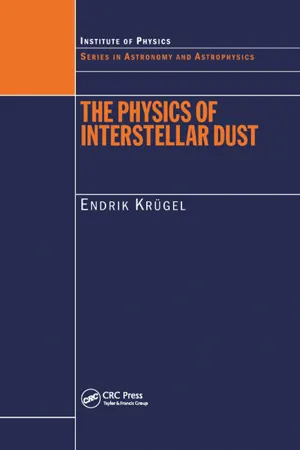
This is a test
- 560 pages
- English
- ePUB (mobile friendly)
- Available on iOS & Android
eBook - ePub
The Physics of Interstellar Dust
Book details
Book preview
Table of contents
Citations
About This Book
Interstellar dust grains catalyse chemical reactions, absorb, scatter, polarise and re-radiate starlight and constitute the building blocks for the formation of planets. Understanding this interstellar component is therefore of primary importance in many areas of astronomy & astrophysics. For example, observers need to understand how dust effects l
Frequently asked questions
At the moment all of our mobile-responsive ePub books are available to download via the app. Most of our PDFs are also available to download and we're working on making the final remaining ones downloadable now. Learn more here.
Both plans give you full access to the library and all of Perlego’s features. The only differences are the price and subscription period: With the annual plan you’ll save around 30% compared to 12 months on the monthly plan.
We are an online textbook subscription service, where you can get access to an entire online library for less than the price of a single book per month. With over 1 million books across 1000+ topics, we’ve got you covered! Learn more here.
Look out for the read-aloud symbol on your next book to see if you can listen to it. The read-aloud tool reads text aloud for you, highlighting the text as it is being read. You can pause it, speed it up and slow it down. Learn more here.
Yes, you can access The Physics of Interstellar Dust by Endrik Krugel in PDF and/or ePUB format, as well as other popular books in Naturwissenschaften & Astronomie & Astrophysik. We have over one million books available in our catalogue for you to explore.
Information
Chapter 1
The dielectric permeability
We begin by acquainting ourselves with the polarization of matter. The fundamental quantity describing how an interstellar grain responds to an electromagnetic wave is the dielectric permeability which relates the polarization of matter to the applied field. We recall the basic equations of electrodynamics and outline how plane waves travel in an infinite non-conducting (dielectric) medium and in a plasma. We summarize the properties of harmonic oscillators, including the absorption, scattering and emission of light by individual dipoles. Approximating a solid body by an ensemble of such dipoles (identical harmonic oscillators), we learn how its dielectric permeability changes with frequency. This study is carried out for three scenarios:
• a dielectric medium where the electron clouds oscillate about the atomic nuclei;
• a dielectric medium where the charge distribution in the atomic dipoles is fixed but the dipoles themselves may rotate; and
• a metal where the electrons are free.
1.1 Maxwell’s equations
At the root of all phenomena of classical electrodynamics, such as the interaction of light with interstellar dust, are Maxwell’s formulae. They can be written in different ways and the symbols, their names and meaning are not universal, far from it. Before we exploit Maxwell’s equations, we, therefore, first define the quantities which describe the electromagnetic field.
1.1.1 Electric field and magnetic induction
A charge q traveling with velocity v in a fixed electric field E and a fixed magnetic field of flux density B experiences a force
(1.1) |
called the Lorentz force; the cross × denotes the vector product. B is also called the magnetic induction. Equation (1.1) shows what happens mechanically to a charge in an electromagnetic fi...
Table of contents
- Cover
- Half Title
- Title Page
- Copyright Page
- Dedication
- Table of Contents
- Preface
- 1 The dielectric permeability
- 2 How to evaluate grain cross sections
- 3 Very small and very big particles
- 4 Case studies of Mie calculus
- 5 Particle statistics
- 6 The radiative transition probability
- 7 Structure and composition of dust
- 8 Dust radiation
- 9 Dust and its environment
- 10 Polarization
- 11 Grain alignment
- 12 PAHs and spectral features of dust
- 13 Radiative transport
- 14 Diffuse matter in the Milky Way
- 15 Stars and their formation
- 16 Emission from young stars
- Appendix A Mathematical formulae
- Appendix B List of symbols
- References
- Index